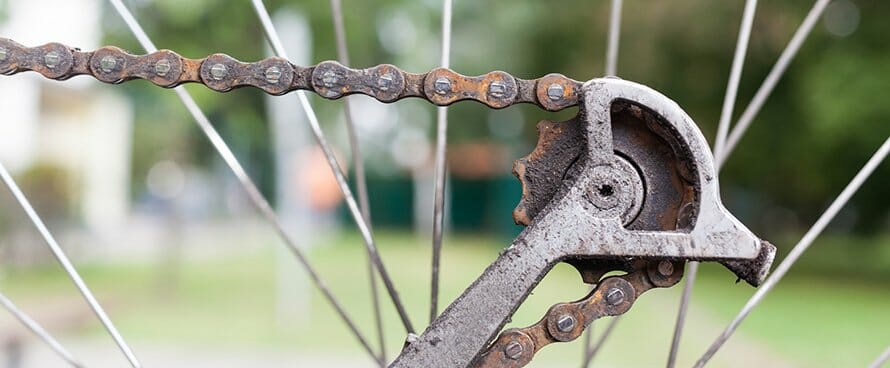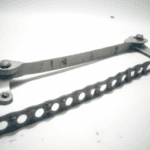Reducing the length of a bicycle chain involves taking out several links to ensure it fits correctly. This step could be essential when you are swapping out an old chain for a new one or adjusting to different gear sizes. Below is a detailed tutorial on how to cut down the length of a bicycle chain:
Tools and materials you’ll need:
- Chain tool (also known as a chain breaker)
- Measuring tape or ruler
- Replacement chain (if needed)
- A clean cloth or rag
- Gloves (optional)
Procedure:
- Shift the bike to the smallest chainring and smallest rear cog: This will create slack in the chain, making it easier to work with.
- Inspect the chain: Look for a master link or quick-release link, which is typically a different color or shape compared to the rest of the chain. If your chain has a master link or quick-release link, use pliers to remove it, then skip to step 5. If not, proceed to the next step.
- Position the chain tool: Place the chain in the chain tool, ensuring that one of the pins on the chain is lined up with the driving pin of the chain tool.
- Remove links: Turn the handle of the chain tool clockwise to push the chain pin out. Be careful not to push the pin all the way out; you want it to stay partially inserted on the outer plate so that you can reassemble the chain later. Remove the chain from the chain tool.
- Measure the chain: Wrap the chain around the largest chainring and the largest rear cog without passing through the rear derailleur. Bring the ends of the chain together, leaving one full inner link overlap. This is where you’ll need to cut the chain.
- Cut the chain: Use the chain tool to break the chain at the measured point. Push the pin partially out, just like in step 4. Remove the excess links.
- Reconnect the chain: If you removed a master link or quick-release link, reattach it now. If not, use the chain tool to push the pin back in and join the two ends of the chain. Make sure the pin is aligned with the rest of the chain and the link moves freely.
- Test the chain: Shift through all the gears to ensure the chain is the correct length and functioning properly. If the chain is too tight or too loose, you may need to add or remove another link.
- Clean up: Use the cloth or rag to wipe off any grease or dirt from your hands and the chain tool.
Remember, always be cautious when working with your bike chain. If you’re unsure about any step, consult a professional bike mechanic.
When deciding to shorten your bike chain, there are a few steps that you need to follow in order to achieve the desired result. First, you should open the master link that holds the rest of the chain links together. Then, you will need to determine how many links you need to remove. Ensure that the number you remove is sufficient to keep the chain tight and smooth.

Avoid Driving out A Factory Connecting Link or A Formerly Installed One-Time Pin
Using a one-time pin or quick link is not the proper way to shorten bike chains. One-time pins are made to be pushed in only once and should not be used to shorten bike chains. A quick link replaces the outer plates of a chain. It may be necessary to replace one or both links if you want to shorten a bike chain.
Before shortening bike chains, take the time to understand your existing chain and the way it is attached. You should be able to identify which part is the fastener by the way it looks like. A quick link will be easy to spot because it has interlocking side plates. You can also identify the type of joining pin by its colour. Shimano joining pins are different from rivets and have a raised ring around the outer circumference.
Once you have determined which link needs to be replaced, you should be able to easily reassemble the chain. If the pin has been damaged, you can replace it with a new one. If you’re not able to buy a new one, you can use a thin nail or a hammer to push it out. Alternatively, you can use a flat-bladed screwdriver to push the pin into place.
Before attempting to shorten bike chain, you should carefully check that the pin has been replaced correctly. Some chains have one-time connecting pins that squishes the plates of a link together laterally. To insert a new one-time pin, you should insert the new one through a pin that is positioned between the outermost plate and the inner link.
While the factory connecting pins and quick links can be removed without damaging the chain, it’s best to follow the recommendations of the manufacturer of the bike chain. By following the instructions, you will have a shorter chain in no time.
If you must shorten a bike chain, you should always make sure that you get the correct sizing. When shortening a bike chain, it’s better to make it longer than shorter. If you’re shortening it by using a one-time pin, you’ll risk damaging the inner link. A broken pin could leave tiny burrs that may get into the cassette teeth.
Most chain failures are the result of improper installation of the pin. The pins on modern chains are so narrow that even a small misalignment can cause the chain to fail under load. To avoid this problem, you should check each pin before driving it into the chain.
Avoid Driving out A Formerly Installed One-Time Pin
When you are shortening a bike chain, it is crucial not to drive out the previous pin that was installed once. If this happens, the chain will not run optimally. To avoid this, count the links from the first pin to the last. Make sure that the distance between the pins is at least 12 inches. If the gap is longer than this, you should replace the bike chain. To check for this, you can loosen the back wheel by pulling backwards.
There are two types of pins on a bike chain: one-time pins and quick-links. One-time pins should be pushed into the normal links, while quick-links can be opened and closed many times.
Before driving out the pin, you should make sure that it is attached to the link. The chain tool is used to remove the pin from the chain. When installing a pin, push it in clockwise until the pin is connected with the other end of the chain pin. You should feel it start coming out from the link. This part is the tricky part. If you push the pin all the way out, you will be unable to replace it.
When shortening a bike chain, you should always remember to install the pin in an equal distance to the neighbors. Reusing the pin will result in a weak link, and a weakened chain will be susceptible to breakage.
Another way to prevent this is to purchase a new pin to replace the old one. Make sure you get one that matches your bike chain’s speed and brand. It will be easier to replace the chain if you don’t use the old one. You can also buy master links for reconnecting the chain. These links must be inserted at both ends of the chain and assembled with a master link tool.
Find the Master Link
If you want to shorten the chain on your bike, you will first need to find the master link. To find it, you can look on the side of the bike, or on the manufacturer’s website. The master link is the widest link in your chain, and is often marked with a rivet. You can remove the rivet using a pair of needle-nose pliers.
You can also use a screwdriver to loosen it. Some bike chains may have a master link attached to it, and you may be able to remove it without a chain breaker. If this is the case, you may need a special tool to pry the link out.
If you are using a fresh chain, make sure it has a master link. Master links are important because they help you to rejoin the chain easily. You can open the master link with pliers or a piece of cable. Next, place the nut on a solid hitting surface and use a pin to penetrate the pin into the chain. Be careful not to hammer out the pin fully.
Once you have located the master link, find the end of the chain closest to it. You may need to use a stand to access the chain better. This can also give you a better view of the entire chain. The master link is normally a longer, thicker, and wider than the rest of the links.
Once you have the master link, you can shorten the bike chain by removing a link from the chain. This is possible to do by following the instructions that come with your bike’s owner’s manual. In addition, you may need to use pliers to remove the retaining pins. You can also use a pair of pliers to prune the chain. Remember to avoid hammering the master link with a steel nail or other sharp object, because you could harm the bike chain.
Another option for shortening a bike chain is to use a quick-release master link. This fastener provides an easy way to attach and remove the bike chain. This is especially useful if you are doing bike repairs or changing the chain. Knowing where to find the master link is crucial to make the chain removal or repair process easier.
You can calculate the length of the bike chain using a chain-length calculator or by simply laying the old chain next to the new one. Make sure to line up the outer plates of the old chain with the inner ones on the new chain. This is particularly important when comparing the old and new chains because the older one will lengthen as it wears.
















